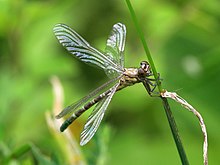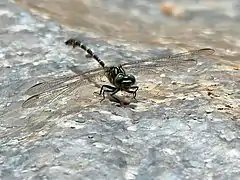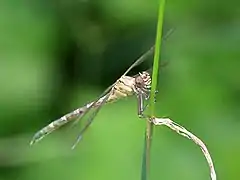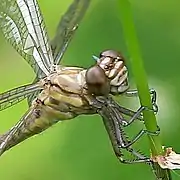Hemigomphus comitatus
Hemigomphus comitatus is a species of dragonfly of the family Gomphidae,[3] known as the zebra vicetail.[4] It is endemic to northern Queensland, Australia, where it inhabits streams and rivers.[5][6]
| Zebra vicetail | |
|---|---|
 | |
| newly emerged, Cairns, Australia | |
| Scientific classification | |
| Kingdom: | Animalia |
| Phylum: | Arthropoda |
| Class: | Insecta |
| Order: | Odonata |
| Infraorder: | Anisoptera |
| Family: | Gomphidae |
| Genus: | Hemigomphus |
| Species: | H. comitatus |
| Binomial name | |
| Hemigomphus comitatus | |
 | |
Description
Hemigomphus comitatus is a small dragonfly with black and yellow markings. Its wingspan is 50-55mm and overall length is 40-45mm.[7] The eyes of the adult are green and do not meet at the top of the head. The head of the female has a spine from the occiput just behind the eyes. The synthorax is strongly marked with black and yellow stripes, with the humeral stripe usually being continuous. A black mark along the suture of the synthorax is usually broken above and below the metastigma. The abdomen is black with prominent yellow bands, the appendages of the male are yellow and curve inwards at the tip. The wing margin at the base of the hindwing is folded in the male, but uniformly curved in the female.[4]
Distribution
Hemigomphus comitatus has been recorded from near Mackay, Queensland to northern regions of Cape York Peninsula, usually along the coastal strip and nearby mountain ranges.[7]
Habitat
Hemigomphus comitatus is known to inhabit streams and rivers, not necessarily in rainforest.[4] The exemplar pictured here was found in suburban Cairns near a seasonal storm-water creek.
Gallery
 Male, front quarter
Male, front quarter Front quarter of teneral female Hemigomphus comitatus
Front quarter of teneral female Hemigomphus comitatus Closeup of head showing patterns on the synthorax and spine on the head.
Closeup of head showing patterns on the synthorax and spine on the head..jpg.webp) Female wings
Female wings.jpg.webp) Male wings
Male wings
See also
References
| Wikimedia Commons has media related to Hemigomphus comitatus. |
- Dow, R.A. (2017). "Hemigomphus comitatus". IUCN Red List of Threatened Species. 2017: e.T14278064A59256723. doi:10.2305/IUCN.UK.2017-1.RLTS.T14278064A59256723.en.
- Tillyard, R.J. (1909). "On some rare Australian Gomphinae, with descriptions of new species". Proceedings of the Linnean Society of New South Wales. 34: 238–255 [245] – via Biodiversity Heritage Library.
- "Species Hemigomphus comitatus (Tillyard, 1909)". Australian Faunal Directory. Australian Biological Resources Study. 2012. Retrieved 19 February 2017.
- Theischinger, Günther; Hawking, John (2006). The Complete Field Guide to Dragonflies of Australia. Collingwood, Victoria, Australia: CSIRO Publishing. p. 190. ISBN 978 0 64309 073 6.
- Theischinger, Gunther; Endersby, Ian (2009). Identification Guide to the Australian Odonata. Department of Environment, Climate Change and Water NSW. p. 219. ISBN 978 1 74232 475 3.
- Watson, J.A.L.; Theischinger, G.; Abbey, H.M. (1991). The Australian Dragonflies: A Guide to the Identification, Distributions and Habitats of Australian Odonata. Melbourne: CSIRO. p. 278. ISBN 0643051368.
- "Atlas of Living Australia". Retrieved 26 April 2017.
